
|
February 26th 2003
The Stanguellini Tradition
Story and photos by Lorenzo Marchesini
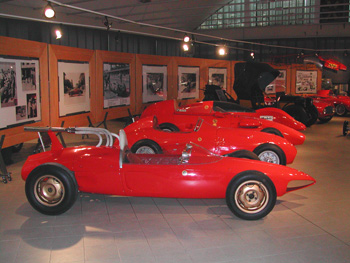
The Delfino Formula Junior is first in a line-up of impressive Stanguellins at the Museum.
|
Situated in Northern Italy at the foot of the Apennine mountains, Modena is located about 15 miles west of Bologna. Modena is famous for the the Italian Military Academy, a centuries old University, numerous churches and piazzas and of course as the epicenter of "Motor Valley". As in most of Italy, the Modenese are fond of their wines, in particular Lambrusco, and their cuisine. It was here that the famous "tortellini" was invented.
But above all, they are fondest of their long tradition of race cars and engineering. While visiting Modena and adjacent areas, it became evident that everyone here is affected by the race car "virus". It made its entry in society in the early 1900's when Francesco Stanguellini first introduced the population to tricycles, Cerano and a Scat, long before he started the first dealership for FIAT in the region.
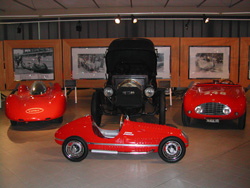
The small race car was built for Francesco by his father Vittorio, along the
lines of the Maserati F1 car of 1953. It was powered by a Ducati 98. In the
background is the Fiat Zero with Modena 1 tags--the first ever car in Modena.
|
Early years of Stanguellini
In 1925 the Stanguellini operation gained national notoriety by establishing a racing team. When, in 1932 Francesco Stanguellini died he was succeeded by his son, Vittorio, still only 19 years-old. Vittorio had an extreme talent for engineering and guided the dealership along the lines that later would be picked up by another great of Italian motorsports, Carlo Abarth. From 1935 onwards Stanguellini became synonymous as a tuner of FIAT cars. Initially the cars built were 750's and 1100's but there was also an effort in the bigger categories such as 2800 cc, all based on FIAT mechanicals. The year 1937 saw the birth of the Squadra Stanguellini, a racing team that was composed of Baravelli and Zanella with Fiat 500's, Rangoni on a FIAT 508 Sport, and last but not least Severi on a Maserati 1500 that was thoroughly modified by Stanguellini. Severi finished 1st overall in the Targa Florio of 1937. The early years saw many more important victories for Squadra Stanguellini, one of the most memorable ones being the class victory of Baravelli at the wheel of a 750 Stanguellini in the Mille Miglia of 1938. With this victory the Stanuellini operation gained international fame.
Pre-War international successes included the triumph Baravelli in the 750 Stanguellini at the Tobruk-Tripoli race of 1939, a victory further underscored by the class wins in the 750 and 1000 cc classes at the Mille Miglia of 1940.
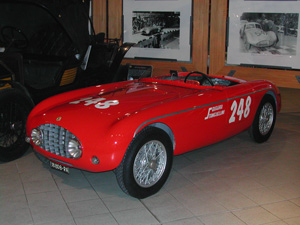
Stanguellini 1100 Sport barchetta Bialbero (twincam) of 1950.
|
Postwar success
After World War II, Stanguellini operations were revived in 1946. Vittorio Stanguellini re-launched his team and in 1946 won the Italian National Championship for sportscars, while in that same year the 1100 Stanguellini with Franco Bertani at the wheel beat the Simca-Gordini driven by the maestro Amedee Gordini himself during the Belgian Grand Prix. The year 1947 saw multiple victories for the Stangellini cars and virtually no Sunday went by without a Stangellini being victorious somewhere. Stanguellini wins included the defeat of official Ferrari entries, notably when Vincenzo Auricchio in a Stanguellini 1100 won the Grand Prix of Pescara ahead of Cortese. Similarly at Florence the Stanguellini again finshed ahead of the Ferrari factory entry of Cortese, as Guido Scagliarini scored another victory on the Circuito Cascine.
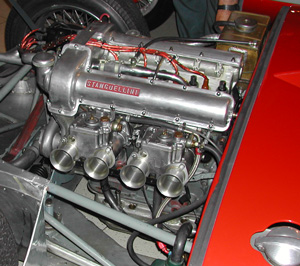
Stanguellini engines, particularly in the 750 and 1100 cc sportscars,
are based on the Fiat, but by the mid fifties, there was very little
of the Fiat motor left in the stunning and powerful DOHC powerplants.
|
In the years thereafter the Stanguellinis gradually used less parts from FIAT and by the early fifties they were fitted with a twincam engine entirely built in-house by Stanguellini, One of the most important 1100cc victories was that of the divers Behm-Haas-McArthur in the 12 hours of Sebring in 1957. By then Stanguellinini had become a household name in the world of international motorsports. Those who visited Modena in those days were often referred by the local population as the "Visitors of the Kingdom of Miracles." Stanguellini was known as the "Dean of Sportscar Manufacturers" and there was a strong friendship between him, Ferrari and Sergio Scaglietti that continued until his death.
One regular visitor to the Stanguellini premises was five times World Champion Juan Manuael Fangio. Vittorio and Fangio were good friends and Fangio suggested many
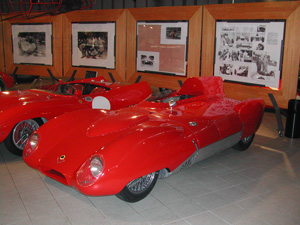
This is a Lotus 11 with the Stanguellini 1100 cc engine, from 1957.
|
changes to the cars that would become so famous as Formula Juniors of the late 50s-early 60s. The Formula Juniors were very successful both in Europe and America, and the list of victories went into the hundreds. A similar to the number of cars were produced. The era witnessed Lorenzo Bandini in a Stanguellini battling with and often finishing ahead of the Cooper of Dennis Hulme, notably at the Grand Prix of Pescara in 1960.
However, the rear engined Formula Juniors from Britain could not be beaten in the 1960's and the rear-engined car by Stanguellini, named the Delfino Formual Junior, a car of unrivaled beauty, failed to stop the march of the Brits as the Fiat 1100 was simply not powerful enough. Remarkably, the Delfino saw its one and only moment of glory when driven by
Walt Hangsen as a driver for team Cunningham it won the pole position at Daytona in 1962, but retired during the race due to mechanical problems. A lack of sponsorship funding made further competing with the British teams impossible.
The last Stanguellini
The 1960s also were the years of the six Monza speed records set with the Guzzi powered Colibri Stanguellini, bodywork of which was designed by Franco Scaglione. The last race car racing car to leave the Stanguellini premises was a Formula 3 built in 1964.Once again a car with lines well ahead of its time, which must have provided an inspiration to the Pederzani brothers in Bologna, who were responsible for the incredibly successful Tecno F2 and F3 cars. Noteworthy is an attempt in 1971 to produce a Gran Turismo of beautiful lines called the Momo Mirage. Regrettably, this initiative, powered with a 5.3 liter Chevrolet engine, died prematurely due to the energy crisis in the early 70ís.
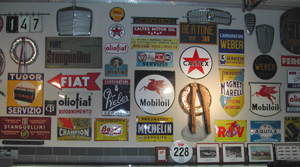
Wall of fame at the Stanguellini Museum. A lot of trophy and signs collected
from 1936 to 1964.
|
Stanguellini Today
Vittorio Stanguellini passed away in 1981 at the age of 72. On the occasion the world sport press remembered him as the "Father of the Formula Junior." He was succeeded at the helm of his enterprise by his son Francesco. Today, Signor Francesco can be seen at the FIAT dealership that he runs as a tight Italian family business with his son Simone and his daughter Francesca,
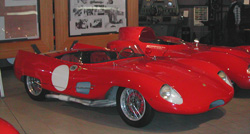
Stanguellini Sela 740 of 1958.
|
who are both avid race car drivers in classic events. What is more important is that they are people who have maintained the heritage passed on to them by maestro Vittorio Stangellini, a heritage that they eagerly share with visitors at their splendid collection housed in the Museo Stanguellini at the back of their FIAT dealership on the via Emilia. The Museum
www.stanguellini.it can be visited free of charge and houses a gift shop where itmes of excellent taste and quality can be purchased at reasonable prices. Note that Stanguellini has all facilities in place to restore, maintain and tune Stanguellini cars while they also have a very interesting array of historic racing cars and thoroughbred classics for sale. A visit to this museum should be priority number one for Italian car enthusiasts while in the Modena area.
Museo Stanguellini c/o Stanguellini SpA
Via Emilia EST 756
41100 Modena
Tel 39-059-361105
Fax 39-059-374845
|

|



